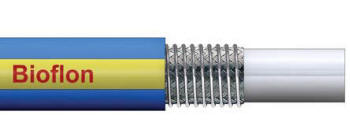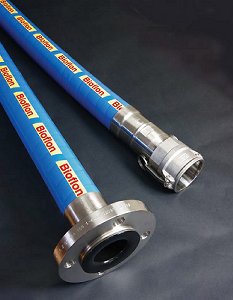|
Hose Construction
- Bioflon Hose includes a smooth bore, thick wall PTFE tube liner. Either Natural PTFE, Grade GP or Antistatic (Black) PTFE, Grade AS.
- A stainless steel wire braid is applied to the outside of the PTFE tube liner.
- A high tensile carbon steel wire is helically wound over the wire braid.
- An abrasion resistant Blue EPDM Rubber Cover or a Clear, Silicone Rubber Cover is hand-wrapped on the outside, which moulds around and conforms to the helical wire, holding the wire in place on the hose.
Notes:
The helical wire provides “hoop strength” to the hose construction, reinforcing the hose against kinking and crushing forces.
No Glue is used in the hose construction to bond layers together, thus preventing any possible contamination of the process fluid.
 Bioflon Brochure US Bioflon Brochure US
|

BIOFLON GRADE GP |

BIOFLON GRADE AS |

BIOFLON GRADE GP, SI |

BIOFLON GRADE AS, SI |
PURPOSE
Bioflon GP is the �General Purpose� grade, for use in all applications where fluids or gases are being conveyed which do not generate a risk of static charge development (see Grade AS�).
MATERIALS & SPECIFICATIONS
Bioflon GP has a virgin PTFE liner, manufactured from hose grade PTFE which conforms to the requirements of: FDA 21 CFR 177.1550.
The PTFE Liner is covered by a Grade 304 SS braid, then a High Tensile Carbon Steel helical reinforcing wire.
An external cover of blue, EPDM rubber (Grade RC) or clear, platinum cured silicone rubber (Grade SI) is applied over the outside of the construction.
GRADE AS (ANTISTATIC)
Bioflon AS is an essential requirement in applications where there is the risk of an electrostatic charge build-up on the inside surface of the PTFE tube which may then discharge through the tube wall. Media passing through which create such a risk are fluids which have a Conductance of less than 10-8 S/m (Siemens per Metre), or 104 pS/m such as fuels, solvents, freons, some WFI (ultra-pure Water for Injection�) an non-polar organics which are being transferred at a medium to high flow velocity.
All twin or multi phase media, and any non-mixing media, such as powder in air, or water droplets in steam, in gases or in oil, also colloidal fluids constitute a particular hazard for static charge generation, and always require grade AS.
If in doubt, consult Carolina Components Group.
| BIOFLON GP AND AS GRADES - SPECIFICATIONS & PROPERTIES |
| Nominal Hose Sizes |
Actual Bore Size |
Outside Diameter |
Maximum Working Pressure |
Minimum Bend Radius |
Maximum Continuous Length |
| in |
mm |
in |
mm |
in |
mm |
psi |
bar |
in |
mm |
Feet |
Metres |
| 2 1/2 |
65 |
2 3/8 |
60.0 |
3.07 |
78 |
300 |
20 |
31 |
800 |
32 |
10 |
| 3 |
80 |
2 7/8 |
73.0 |
3.80 |
96.5 |
230 |
16 |
39 |
1000 |
32 |
10 |
*Fitting Lengths listed are for RC Grade Hose end fittings. SS and PB Grades end fittings are shorter in length.
SELECTING THE HOSE LENGTH:
Bioflon hose assemblies are made up to the specific lengths required. The hose length is taken as the length from the sealing face at one end of the hose to the same at the other end. The length tolerance is normally +5%-0%. Closer tolerances are available to special order.
TEMPERATURE RANGE:
Blue EPDM Rubber Covered -40�C to +140�C (-40�F to +284�F), Clear Silicone Rubber Covered -73�C to +204�C (-100�F to +400�F).
VACUUM RESISTANCE:
Dependent upon temperature and degree of flexing.
FLEXIBILITY AND KINK RESISTANCE:
Comparable with other Smooth Bore PTFE/PFA/FEP lined hose products with a rubber cover.
FIRE RESISTANCE:
Fire Resistant to BS5173 Section 103.13 Parts 6.2 and 6.3
BIOFLON HOSE: SPECIAL USAGE CONDITIONS
- CLEANING & STERILISING SYSTEMS - CIP, SIP AND AUTOCLAVE
CIP & SIP � PTFE liner tubes are chemically resistant to all CIP, SIP and Autoclave conditions. The primary consideration is whether the cleaning and purging cycle is likely to develop an electrostatic charge on the internal surface of the liner, in which case AS (Anti-Static) grade hose is required.
AS grade hose and Electrostatic charge generating systems are fully described in the hose liner section. CIP systems using high electrical resistivity solvents like Toluene will require AS grade hose.
Another electrostatic generation problem arises when wet steam is used, or when the cleaning fluids or WFI are purged out of the line using nitrogen, compressed air or another gas, because droplets of liquid or water in the gas then generate a multi-phase condition until they are cleared out, which will generate a static charge, and so will require AS grade hose.
In static generating applications where AS grade hose is not acceptable due to the black PTFE liner, alternative solutions are available. Please consult Carolina Components Group for advice.
Autoclave � Autoclave sterilisation does not normally involve any high flow rates through the hose bore, so static generation is not a problem. Aflex hose grades GP and AS, with SS or HB braids are fully resistant to all autoclave conditions throughout the service life of the hose.
The rubber covered grades EPDM, (RC) and Silicone Rubber (RC, SI) are able to withstand at least 100 x 30 minute autoclave cycles at relatively high autoclave temperatures (121�C, 250�F or 135�C, 275�F). Consult Aflex Hose for more specific information.
- PTFE HOSE-USE WITH ALKALI METALS, HALOGENS AND HALOGEN CONTAINING CHEMICALS
PTFE hose liners react chemically with Fluorine, Chlorine Trifluoride and molten Alkali Metals.
When PTFE lined hose is used to carry Chlorine or Bromine, either as gasses or fluids, they will diffuse into and through the PTFE liner wall thickness. Trace quantities will then combine with atmospheric moisture to corrode any braid/rubber outer coverings.
Heavily halogenated chemicals, like Hydrogen Fluoride, Hydrogen Chloride, Phosgene (Carbonyl Chloride) Carbon Tetrachloride and other organic chemicals with a high halogen content can also be absorbed and transmitted through the PTFE liner tube.
- OTHER “PENETRATING” FLUIDS AND GASES
Sulphur Trioxide, Methyl Methacrylate, Caprolactam and Glacial Acetic Acid are some other chemicals which can be absorbed and transmitted through the PTFE liner tube wall. Generally, however, as a hydrophobic (non-wetting) material, PTFE is very resistant to the absorption of chemicals. In some cases, PTFE has superior resistance to diffusion, for example to the diffusion of automotive fuels, in comparison with all other plastics and rubbers.
- GAS/FLUID CYCLING
There are some applications where the fluid passing through the hose turns into a gas, then back into a fluid, then into a gas etc, in a cyclic sequence.
This is normally associated with changes in temperature and/or pressure. For complex reasons these conditions are extremely damaging to the hose liner, whatever material it is made from.
For example, hoses are sometimes used to pass steam, water, steam etc into rubber moulding presses, in order to heat the mould, then rapidly cool it before reheating in the next cycle. Hoses of all types fail rapidly in such an application and PTFE lined hoses are no exception.
Please contact Carolina Components Group for further information if these conditions apply.
- CONNECTING ASSEMBLIES FOR USE IN APPLICATIONS
The lengths of hose assemblies and their configuration in use when connected into the application must always be in accordance with the Hose Configuration information at the end of this product literature.
When being connected for use in applications, the end fittings on hose assemblies must be connected to correct mating parts in the correct way, using the correct tools, spanners, clamps, nuts and bolts etc. The connections must be sufficiently tightened to ensure that the joint is leak free but not be over tightened as this can damage the sealing surfaces, especially with PTFE lined and flared end fittings.
In applications involving the transfer through the hose of expensive or dangerous fluids or gases, the hoses and connections must be pressure tested in situ before being put in to service. This should be done with some harmless media to 1� times the maximum working pressure of the hose assembly, as stated in the product literature. If in doubt please contact Aflex Hose for advice.
- SPECIAL APPLICATIONS
Aflex Hose PTFE lined hose products are not rated as suitable for use in the following, special applications:
All Radioactive Applications involving high energy radiation, including Gamma radiation (degrades PTFE)
All Medical Implantation Applications.
All Aerospace Applications.
QUALITY ASSURANCE, CERTIFICATION & APPROVALS and HOSE TESTING
BS EN ISO 9001:2008
Aflex products are all manufactured in accordance with BS EN ISO 9001: 2008 Quality Management Systems independently assessed and registered by National Quality Assurance Limited (NQA).
USP CLASS VI AND ISO 10993-5, 6, 10 & 11 GUIDELINES
Natural and Antistatic PTFE Hose Liners, Platinum Cured Silicone Rubber Covers (White and Clear) and EPDM Rubber Cover (Blue) have been independently tested in accordance with USP protocols and are found to conform to the requirements of USP Class VI Chapter <88>.
Natural and Antistatic PTFE Hose Liners, Platinum Cured Silicone Rubber Covers (White and Clear) have also been tested in accordance with USP protocols and are found to conform to the requirements of USP Class VI Chapter <87>, the L929 MEM Elution Test and are considered non-cytotoxic.
FDA
The Materials used to manufacture the natural PTFE Tube liner conforms to FDA 21 CFR 177.1550, and the antistatic PTFE liner conforms to FDA 21 CFR 178.3297.
3-A SANITARY STANDARDS
The PTFE used in the liner is manufactured solely from materials which meet the requirements of the 3-A Sanitary Standards.
CHEMICAL MANUFACTURERS APPROVALS
Most of the major chemical manufacturing companies in the world have audited and/or approved Aflex Hose as a Hose Supplier.
BPSA LEACHABLES and EXTRACTABLES TESTING
Aflex Hose Natural and Antistatic PTFE Hose Liner Tube has been independently tested in accordance with BPSA recommendations, and found to be satisfactory. Copies of the Test Report are available for specifi c assessments to be made.
CE MARKING (EUROPE ONLY)
Aflex has been assessed by Zurich Engineering and found to comply with the Pressure Equipment Directive 97/23/EC (European Community) Conformity Assessment Module D1, approved to CE Mark applicable hose products, accompanied by a Hose Usage Data Sheet, and a Declaration of Conformity.
ATTESTATIONS OF CONFORMITY TO ATEX DIRECTIVE 94/9/EC (POTENTIALLY EXPLOSIVE ATMOSPHERES)
Available for hose assemblies components� used in Gas Zones 1 & 2 and Dust Zones 21 & 22, when applicable.
MATERIAL CERTIFICATION TO EN10204
Available for all the hose or hose assembly components.
CERTIFICATES OF CONFORMITY TO BS EN ISO/IEC 17050
Are available for all products.
HOSE TESTING
Each assembly is pressure tested to 1.5 times maximum working pressure before despatch, and pressure test certificates can be supplied. |








